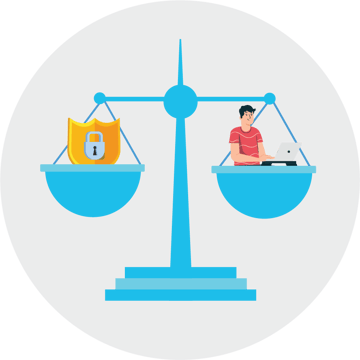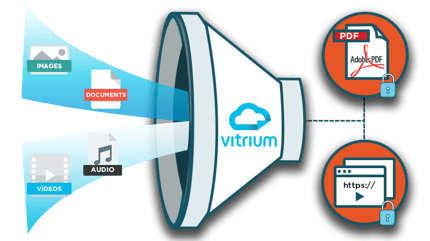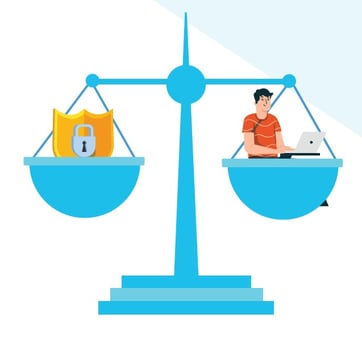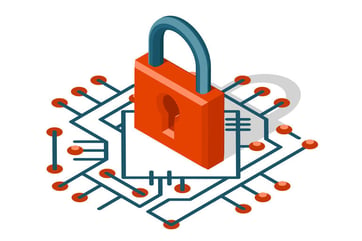Vitrium Security provides you with ironclad protection, and a choice of various pain-free distribution methods to share your valuable content!
The Balance Between Content Protection & Ease of Use
Implementing an enterprise-level content protection or digital rights management (DRM) software may seem extremely daunting. You might feel it will present challenges for your organization and customers (or students, members, users, etc.), as it used to be common knowledge that implementing a DRM solution would require some "jumping through hoops. People would have difficulty accessing their content, as they would have to download a 3rd party app, then follow a series of steps to authenticate their device, and install a plug-in for each type of program or device they used. All of this led to many frustrations and obstacles for the end users, who eventually moved on to get their content from some other organization.

Gone are those days!
There’s no need to believe that by encrypting your content or applying DRM controls to it, you’ll be giving up the ability to provide a good user experience. It is possible to balance both needs with a modern DRM system. A good DRM system will offer this balance and allow you to fully reap the benefits of having your valuable or confidential content protected, without having to compromise your user experience.
Protect your content. Protect your business.
Intellectual Property Worth Protecting
You may be unaware of which assets within your organization can be classified as intellectual property (IP). Then trying to determine which of those assets are worth protecting and how to protect them may be further perplexing. The reality is that your company likely possesses extremely valuable intellectual property and failing to protect it could result in very serious consequences. Let’s first start by defining “what is intellectual property”.
.jpg?width=374&name=Intellectual-property(1).jpg)
Intellectual property (IP) is best described as the varying set of intangible assets that are owned by any given company and can range anywhere from patents, to trade secrets, to employee know-how. Intellectual property protection should be a top priority for companies, especially those that create, produce or distribute valuable material such as eBooks, course materials or other educational content, training videos, market reports, standards documents, technical guides, manuals, board materials, trade secrets, and more.
As explained by Marsh, a global leader in insurance broking and risk management, categorizing Intellectual Property as an asset allows it to have the “same protective rights as physical property.”
The risks of failing to protect your IP go far beyond your time and resources being wasted, it is the lifeblood of your company and a direct result of your team’s intellectual activity.
Should this information fall in the hands of unauthorized users or competitors, your bottom line would surely be threatened. Some of the risks pertaining to intellectual property infringement include loss of revenue, devaluation of your content, and the damage of your reputation.
Implement a Hassle-Free DRM Solution
Protecting your intellectual property is more important than ever and quickly becoming a top priority, especially as more companies have shifted to creating and distributing more digital content as a result of the coronavirus pandemic. eBooks, course materials, videos, market reports, technical guides, standards documents and board materials can very easily be copied or shared, putting companies at high risk of having their IP violated. Digital rights management (DRM) systems are specifically tailored for protecting digital content and preventing such misuse.
However, some decision-makers remain skeptical of implementing a DRM solution and the reason is primarily due to misconceptions and erroneous assumptions that have been around for years. One such erroneous assumption is that a DRM system requires cumbersome steps for the end user to follow, often including steps to download a plug-in or 3rd party app before being authenticated to access protected content. This results in hassles, mistakes, and ultimately more support calls for your front-line teams. But there are solutions in the market today that focus on providing a ‘seamless user experience’.
 Vitrium’s DRM solutions, for example, don’t require end users to jump through hoops or download additional software to get access to their content. They can access content using a secure and modern HTML5 web viewer or downloading a protected PDF file that can be opened in Adobe Reader DC or Acrobat Pro DC without the use of any plug-ins, apps or 3rd party software.
Vitrium’s DRM solutions, for example, don’t require end users to jump through hoops or download additional software to get access to their content. They can access content using a secure and modern HTML5 web viewer or downloading a protected PDF file that can be opened in Adobe Reader DC or Acrobat Pro DC without the use of any plug-ins, apps or 3rd party software.
And Vitrium’s implementation is straightforward. Your company can choose to get started right away with Vitrium Security Professional Edition and its built-in, customizable user portal, or take a few more weeks to have Vitrium Security Enterprise Edition integrated with your organization’s main business system such as a learning management system (LMS), an e-commerce system, an association management system (AMS), member system, or other system. Customers who sell their content through a multi-channel distribution network can choose VitriumOne which is a solution provided by Vitrium and its partner, Blue Flamingo Solutions, offering DRM and content distribution capabilities all in one.
Protect Your Content & Increase Your Revenue
Contrary to what is widely believed, settling on a DRM solution does not need to hinder the user experience, nor does it need to be considered a ‘cost resource’.
In fact, if utilized well, a DRM system can also help you increase your revenue.
‘How?’ you may ask!

A quality DRM solution will offer multiple DRM policies and controls and allow you to apply different policies to different groups of people. By setting policies that have different degrees of restriction or leniency, you can sell your content at different rates and position certain products as more exclusive assets.
For example, you can apply more restrictive controls and limited access for your most basic subscription or standard products, and progressively add more lenient controls and access options for those at a higher price-point. Positioning your content this way and leveraging the options you have with a DRM system, not only are you protecting your content and your IP, but you’re also creating options to increase your revenue.
The DRM policies you decide upon will also provide different degrees of ease-of-use, or “freedom,” for your customers. You could, for example, determine how much freedom users are granted depending on the kind of subscription they have to your content. Those who want to benefit from being able to print their content, access it on multiple devices and have the option to view content offline can choose to pay more through a “premium” subscription.
Table 1: Implementing Different DRM Policies to Position Different Price Points
| Subscription Type | Sample DRM Policy | Price |
| Standard Subscription | No printing, 1 device access, no offline access | Lower price point |
| Premium Subscription | Allow printing, multiple-device access, up to 30 days offline access | Higher price point |
Using Content Analytics to Improve Engagement
There are several different DRM systems in the market, but when it comes time to choose one, be sure to evaluate their reporting and analytics capabilities. Basic reporting often includes user activity tracking so you can see a list of which users opened which content, on what date and time, from which IP addresses, from which browsers or operating systems, and so on. But the more advanced DRM systems should also offer drill-down analytics data so you can find out how long someone spent reading a document or watched a video, what pages someone read of a document, and so on. It’s data like this that can provide you very valuable insights to understand how your content is performing, and how your users are engaging with it.
If you see, for example, that most users are only reading through 50% of your training documents, then perhaps it’s worth reviewing the documents to see how you can cut them down, improve the readability, or make them more concise.
The same goes for videos. If you see, for example, that users are only getting through 1 hour of your 4-hour videos, perhaps that’s a sign that the videos are too long to watch in one sitting. You can consider ‘modularizing’ the content by splitting them into 4 separate, 1-hour video files. Then reassess the data after some time to see if your viewing rate increases.
Naturally, your revenue comes from the content you are working tirelessly to produce and distribute, therefore, you want to ensure this content is as close to what your users require as possible.
Being able to analyze how your content is being accessed and how users are engaging with it will provide you detailed insights that you can make informed business decisions about, thus, resulting in positive changes.
Table 2: Leveraging Content Analytics to Improve User Engagement
| What Content Analytics Revealed | Changes Made to Content | Results of Changes |
|
Low read-through-rate (RTR) on training documents (30-day average: 24%) |
|
Increased RTR to 75% over 30-day average |
| Low time spent watching 1 video (4 hours in length, average time spent: 1.25 hours) |
|
Increased total time spent for all videos to 3.75 hours |
| Low number of users accessed all content (documents only, 50 out of 120 users accessed content) |
|
Increased total number of users accessing all content to 115 out of 120 users |
Content Protection & Ease of Use: Achieving The Right Balance
Finding the perfect balance between the security needed for your content and the ease of access needed for your users is not an easy task. Deciding on which encryption methods or digital rights management (DRM) policies to use in order to obtain ironclad protection, while at the same time guaranteeing a pleasant user experience can seem impossible to achieve. However, by debunking the misconceptions that surround DRM, understanding what modern DRM systems are in the marketplace today and how they can be implemented in more straightforward processes, you should be able to find that optimal balance. Your valuable content or intellectual property can be thoroughly protected, and your customers can be offered a platform or methods that are user-friendly and easy to access.
The key is choosing the right DRM system. A modern, high-quality solution, such as Vitrium Security or VitriumOne, that doesn’t require users to download any 3rd party apps or plug-ins, yet simplifies the content protection and distribution process, may just be the right solution for your organization!
Learn more about how Vitrium can help you protect your content - request a demo today!
Click here to download the PDF file
Protect Your Content. Protect Your Business.
Consider Vitrium for Your Content Protection & DRM Needs.





